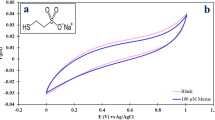Abstract
In this study, the synthesis and properties of a selective electrochemical sensor for the determination of osimertinib (OSIM) as an anticancer drug using the bimetal-organic framework (MOF) were reported. Herein, MOF based on nickel/manganese (Ni/Mn-MOFs) was successfully created using the solvothermal method and applied for the amperometric detection of OSIM. Then, Ni/Mn-MOF was analyzed through a field emission scanning electron microscope (FE-SEM) and X-ray diffraction (XRD). The electrocatalytic performance of the introduced MOF is used in the electrochemical determination of the OSIM drug. The synthesized MOF leads to a noticeable improvement in the electrochemical performance which is ascribed to the many electrocatalytic sites, wide electrode–electrolyte contact area, and excellent electrical conductivity. This is the first study on the use of Ni/Mn-MOF to detect of OSIM. The Ni/Mn-MOF modified glassy carbon electrode (Ni/Mn-MOF/GCE) exhibited a good linear range from 0.5 to 800 μM and 800 to 1800 μM with a low detection limit (LOD) as 0.16 μM. In addition, the proposed sensor possessed good anti-interference properties, repeatability, stability, and reproducibility. The mentioned substrate to detect OSIM in the samples of blood serum was successfully applied. This research displays that MOFs are reliable materials for designing effective electrochemical sensors to detect drugs easily. The existing research results provide insights into the promotion and development of the bimetal-organic framework in the field of electrochemical applications and promising for usage in other electrochemical studies.










Similar content being viewed by others
Data Availability
The datasets of the current study are available from the corresponding author on reasonable request.
References
Y. Li, L. Meng, Y. Ma, Y. Li, X. Xing, C. Guo, Z. Dong, Molecules 27, 4474 (2022)
H. Sung, J. Ferlay, R.L. Siegel, M. Laversanne, I. Soerjomataram, A. Jemal, F. Bray, CA Cancer J. Clin. 71, 209 (2021)
M.N. White, Z. Piotrowska, K. Stirling, S.V. Liu, M.K. Banwait, K. Cunanan, L.V. Sequist, H.A. Wakelee, D. Hausrath, J.W. Neal, Clin. Lung Cancer 22, 201 (2021)
Z. Yuan, X. Yu, S. Wu, X. Wu, Q. Wang, W. Cheng, W. Hu, C. Kang, W. Yang, Y. Li, X.-Y. Zhou, Front. Pharmacol. 13, 928983 (2022)
D. Ayeni, K. Politi, Clin. Cancer Res. 21, 3818 (2015)
C.S. Tan, D. Gilligan, S. Pacey, Lancet Oncol. 16, e447 (2015)
Z.M. Karazan, M. Roushani, Talanta 246, 123491 (2022)
J. Yang, C. Zheng, P. Xiong, Y. Li, M. Wei, J. Mater. Chem. A 2, 19005 (2014)
S. Rani, S. Kapoor, B. Sharma, S. Kumar, R. Malhotra, N. Dilbaghi, J. Alloys Compd. 816, 152509 (2020)
L.H. Wang, D.D. Jia, L.J. Yue, K. Zheng, A.T. Zhang, Q. Jia, J.Q. Liu, A.C.S. Appl, Mater. Interfaces 12, 47526 (2020)
C.K. Gu, W.Z. Wang, J.B. Hu, J. Liu, Fuel 279, 118431 (2020)
X.H. Cao, C.L. Tan, M. Sindoro, H. Zhang, Chem. Soc. Rev. 46, 2660 (2017)
C. Xu, Y. Feng, Z.M. Mao, Y.J. Zhou, L. Liu, W.H. Cheng, J.P. Wang, H. Shi, X. Liu, J. Mater. Sci. Mater. Electron. 30, 19477 (2019)
L. Liu, Y. Zhou, S. Liu, M. Xu, Chem. Electro. Chem 5, 6 (2018)
X. Kang, Y. Ma, J. Wang, X. Shi, B. Liu, F. Ran, J. Mater. Sci. Mater. Electron. 32, 13430 (2021)
K. Tian, Y. Ma, Y. Liu, M. Wang, C. Guo, L. He, Y. Song, Z. Zhang, M. Du, Sens Actuators B Chem 303, 127199 (2020)
F. Su, Q. Jia, Z. Li, M. Wang, L. He, D. Peng, Micropor Mesopor Mat 275, 152 (2019)
A.M. Abdel-Aziz, H.H. Hassan, I.H.A. Badr, ACS Omega 7, 34127 (2022)
Z. Rahmati, M. Roushani, H. Hosseini, Sens Actuators B Chem 324, 128730 (2020)
S. Sundriyal, S. Mishra, A. Deep, Energy Procedia 158, 5817 (2019)
H. Hu, X. Lou, C. Li, X. Hu, T. Li, Q. Chen, M. Shen, B. Hu, New J. Chem. 40, 9746 (2016)
J. Li, J. Li, D. Yan, S. Hou, X. Xu, T. Lu, Y. Yao, W. Mai, L. Pan, J. Mater. Chem. A 6, 6595 (2018)
G. Zou, H. Hou, X.Y. Cao, P. Ge, G. Zhao, Y. Dulin, X. Ji, J. Mater. Chem. A 5, 23550 (2017)
W. Cheng, X.F. Lu, D. Luan, D.X.W. Lou, Angew. Chem. Int. Ed. 59, 18234 (2020)
X. Ma, K. Tang, M. Yang, W. Shi, W. Zhao, J. Mater. Sci. 56, 442 (2020)
S. Farokhi, M. Roushani, H. Hosseini, Electrochim. Acta 362, 137218 (2020)
Funding
This study is supported by the College of Science, Department of Chemistry, Ilam University and the Central Laboratories Directorate, Iraqi Atomic Energy Commission. This study is supported by the College of Science, Department of Chemistry, Ilam University.
Author information
Authors and Affiliations
Contributions
Zahra Mirzaei Karazan: resources, investigation, writing original draft, data curation. Mahmoud Roushani: supervision, conceptualization, methodology, validation, funding acquisition, writing—review and editing.
Corresponding author
Ethics declarations
Competing Interests
The authors declare no competing interests.
Additional information
Publisher's Note
Springer Nature remains neutral with regard to jurisdictional claims in published maps and institutional affiliations.
Rights and permissions
Springer Nature or its licensor (e.g. a society or other partner) holds exclusive rights to this article under a publishing agreement with the author(s) or other rightsholder(s); author self-archiving of the accepted manuscript version of this article is solely governed by the terms of such publishing agreement and applicable law.
About this article
Cite this article
Karazan, Z.M., Roushani, M. A Sensing Platform Based on Ni/Mn Bimetal-Organic Framework for Electrochemical Detection of Osimertinib. Electrocatalysis 15, 110–119 (2024). https://doi.org/10.1007/s12678-023-00857-4
Accepted:
Published:
Issue Date:
DOI: https://doi.org/10.1007/s12678-023-00857-4




